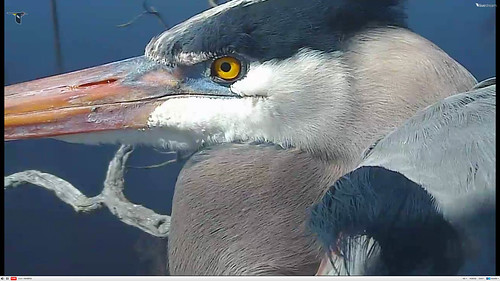
One year ago today, on May 3, 2015, I went birding in Sapsucker Woods in Ithaca, NY, hoping to reconnect with someone very dear to me. He’d never once sent me an email or text, and I didn’t know if he’d show up while I was there, but hope springs eternal. Cornell University has a lot of prominent, world-famous professors and researchers, but the guy I so yearned to see wasn’t among them. He was an unemployed yet self-sufficient, hard-working recluse—the quintessential outdoors guy, into fishing and woodworking and building, yet surprisingly tender and patient with young ones. He was a true blue, all-American Great Blue Heron.
Sapsucker Woods has almost certainly been home to Great Blue Herons since the ponds formed. My personal experience with them there began with the first time I ever visited the Cornell Lab, in April 2006. During the time I was living in Ithaca while I worked at the Lab, from January 2008 through April 2010, Great Blue Herons could be seen every time I took a walk around the pond. My first spring in Ithaca, I thought one heron seemed unusually calm and tolerant of my presence, but figured that was just Cornell karma.
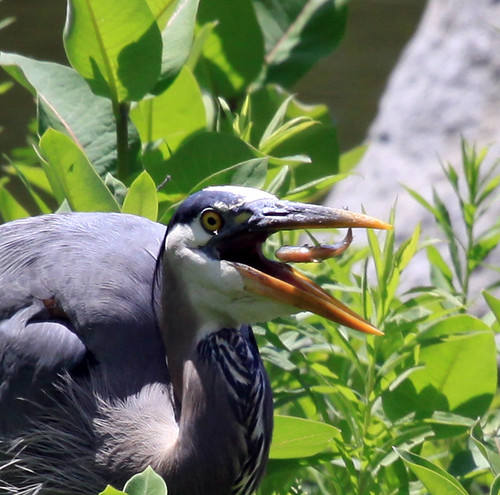
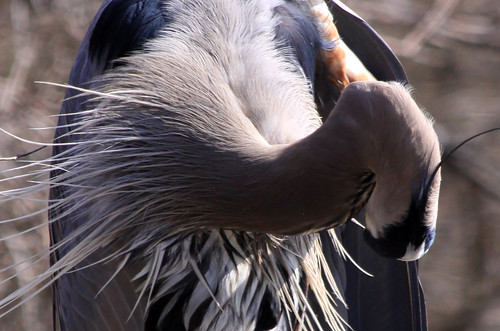

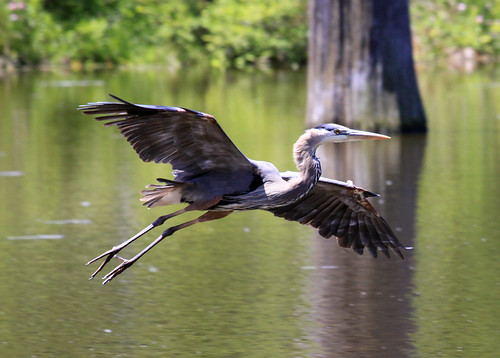
In 2009, I got my first DSLR camera, and that’s when I started taking hundreds, and then thousands, of heron photos. That was also the spring that a pair of Great Blue Herons constructed a nest in the pond. Every day I took photos of the growing family—they successfully raised 4 babies that year.
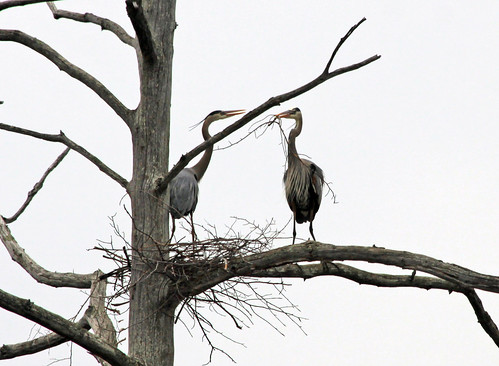
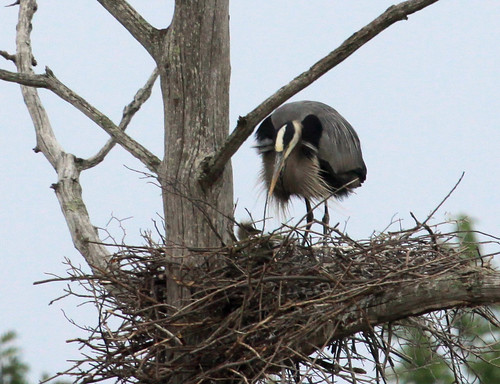

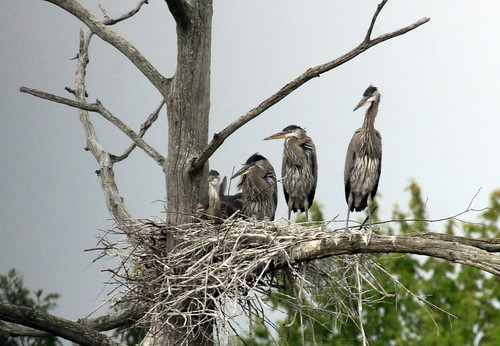
I was at the Lab during a major thunderstorm when the chicks were still little (but didn't bring my camera that day—it was raining). The female hunkered down on the nest. The male stood up at the edge of the nest, facing the full brunt of the storm with his wings slightly opened to umbrella his mate and young, and held fast, buffeted by powerful winds, pelted by rain and some hail, for the duration.
I left Cornell in April 2010, but not before a pair of herons arrived at the nest again.
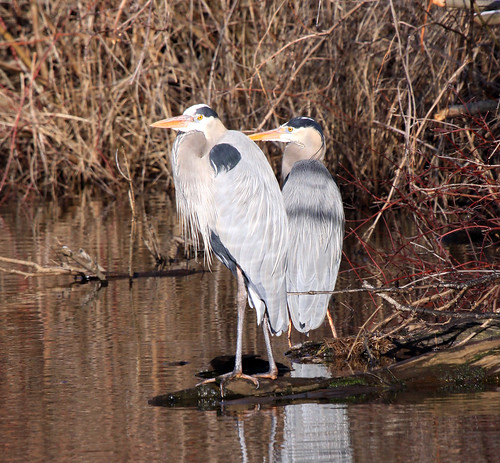
That was the spring Kevin McGowan noticed something unusual about the male at the nest: he was missing the hind toe on his right foot. I started scrutinizing my photos and, sure enough, the male who built the nest the previous year was missing his hind toe. And that unusually tame Great Blue Heron I’d taken so many photos of in 2009? He was the exact same individual bird! I started thinking of him as “Dad.”
I was gone through the nesting season in 2010 and 2011, but people at the Lab watched Dad and his mate—there was no way of knowing whether she was the same one or not—successfully fledge four chicks both years. Then in the winter in 2012, long before any herons returned, Cornell put a couple of cameras in the nest—nest cams that would stream live on the internet so we could watch the birds raise their family up close and personal. I was asked to be a monitor in the chat room. And though I was 1200 miles away, this was one of the most thrilling experiences I’ve ever had watching individual birds.
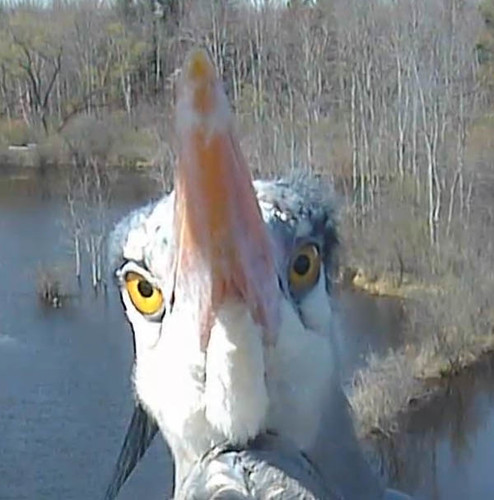
That year they produced five eggs, and despite a few attacks by a Great Horned Owl leading to one egg getting cracked, a late winter storm, and other tricky situations, all five hatched, and all five successfully fledged.
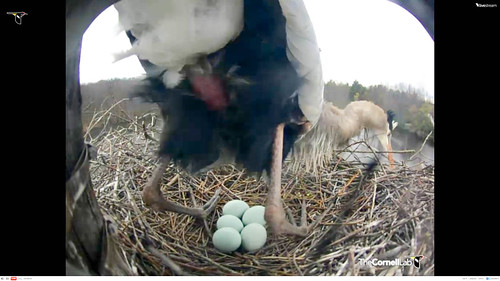
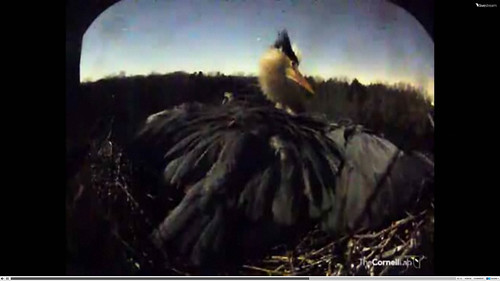

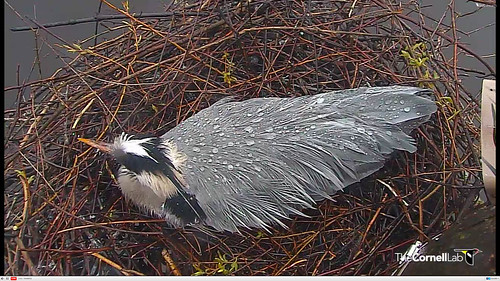
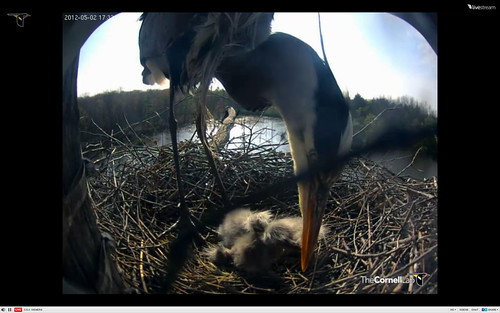
In 2013, the female appeared to be a new one, but Dad, missing that right hind toe, was back and the pair again produced four eggs and raised the four chicks to fledging. The nest fell out of the tree in 2014 before egg-laying began.
Then last year late in the season, Dad got into a fight with another heron, and his foot got hurt—one front toe was badly broken. He hobbled about at first, but the toe seemed to be healing.
Banded Great Blue Herons in Texas have survived 23 and 24 years. I don’t know if Dad's being attacked and injured was evidence of advancing age—we have no idea how old he actually was. But this year, for the first year since at least 2009, Dad has not returned to Sapsucker Woods. We don't know for certain that he's dead, and unless his death had been witnessed or his body retrieved, we could never be sure about the date or time of his demise. Few wild birds get obituaries.
It’s hard to tell individual birds apart—that’s the whole reason scientists mark them with leg bands, wing tags, and electronic trackers—and it’s hard to place a value on an individual bird. Dad produced at least 21 fledgling herons over his lifetime, making a genetic mark on his species. He also inspired a lot of human beings, who will never forget how he stayed on that nest through a snow storm; how he tenderly nurtured his chicks, always making sure to deposit the food in the nest nearest to the littlest chick; how when he regurgitated a still-alive goldfish in the nest to the utter shock of the babies, he patiently showed them that even though it moved—something no regurgitated fish had ever done in their experience—it was still food; how he was a constant presence in Sapsucker Woods, not shying away from people but always certain of himself and his absolute right to a love, his nest and territory, and good food.
I learned to love Great Blue Herons more as I came to know this one individual better. The last few years, the moment there was even a slight break in wintry weather in February I started impatiently awaiting news that Dad had reappeared, each year breathing a sign of relief as soon as someone reported seeing him. I treasure my memories of the time I spent with him last May 3, all the time I spent with him in person during my years at Cornell, and all the time I spent watching him via Cornell's nest cam, not in person but somehow even more intimately. Now there is a gaping hole in my universe—a dark and empty void that, like Rachel's children, cannot be restored.
The world will go on without Dad, as it will one day go on without me. But I’m grateful that his and my paths intersected during our finite stays on this little planet. For the rest of my life, whenever I see any Great Blue Heron, I’ll think of one in particular, and smile.
